Sake from The Frozen North - Day 1, Heading North to Yonezawa
POSTED ON 28/03/2015Sake Brewery Tours set the scene but could the summary of what to expect live up to expectations?
“This is going to be a sake fan’s dream tour with visits to four sake breweries across the Tohoku region, one each day, bridging the contrast between the snowy mountains of Yamagata and Miyagi’s Matsushima Bay. Sake and onsen hot springs are the theme for this tour. Start exploring Yamagata with a sake and Yonezawa beef pairing at your welcome dinner. In addition to visiting eminent breweries, highlights in Yamagata include helping to brew sake at Dewazakura, making soba, trekking up the mountain to see the Snow Monsters, then, soaking in onsen in Zao. On the last two days, experience the coastal side of Miyagi in Matsushima, which has made a tremendous recovery from the disaster of March 11. Enjoy feasting during our visit to a working fish market, munching steamy hot oysters at a pop-up shack, and simply relaxing in beautiful onsen hot springs by the serene bay”.
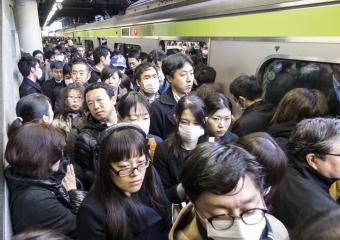 Monday Morning Rush Hour in Tokyo
Monday Morning Rush Hour in Tokyo
Day 1 – Toko , with John Gauntner
The Sake Adventurers Take the Bullet Train North
Our group of 14 sake adventurers assembles on a cool winter’s morning on Tokyo station platform to take the Tsubasa 131 Shinkansen Bullet Train the two hour trip up north. Our destination is Yonezawa, the castle town of the Uesugi Clan in Yamagata in the Tohoku region of northern Honshu. Etsuko, our solicitous and informative leader, helps with the introductions. Adding to the sense of anticipation, John Gauntner, the world’s leading authority on sake, is with us for the day.
If Robert Altman had been auditioning for a film about a Sake Brewery Tours group, he couldn’t have done a better job mingling nationalities and ages with a fair balance of the sexes too. There’s Aussie Dwight and his mother, Coral, Eduardo, the Brazilian restaurateur and his four customers, Roberto, from Brazil with partner, Maria Teresa, and his son, Ricardo, and friend Carlos.
There are two young Taiwanese women, Esther and Mon, and two Americans, Hung, the man with with three cameras, Scott, a thoughtful American living in Tokyo, Keen, a young man from Shanghai and Puranjaya, a fitness professional from Goa. Oh yes, and The British Journalist. Could this be one of the reasons why such a motley crew gelled right from the start? That, and the fact that despite our varying levels of knowledge (Eduardo and Hung had been on previous tours) we all shared one thing in common: we knew how to enjoy a bottle or two of sake.
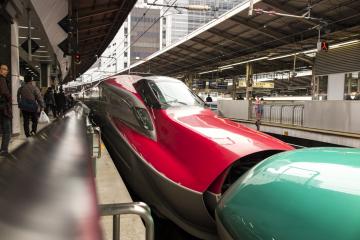 Shinkansen
Shinkansen
I lucked out. Finding myself sitting next to John Gauntner on the Shinkansen, I quizzed the sake guru on current sake trends. The two-hour train ride took us north into Yamagata snow country as far as Yonezawa, which is the neck of the Easter Island head that is Yamagata Prefecture. As we approached Yonezawa, the countryside was blanketed in an increasingly thick white duvet of snow.
In Yonezawa, the snow had been shovelled to the roadsides by snowploughs, and although piled high up against buildings, it had begun to compact down into precarious-looking sheets of wedding cake icing and slide off rooftops in thick layers. Snow was piled six to eight feet high outside the window of the old merchant manor restaurant so there was little view, but no matter. We were more concerned with what was going on inside.
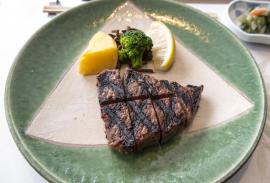 Yonezawa beef
Yonezawa beef
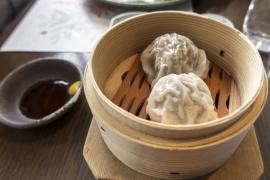 Steamed meatballs
Steamed meatballs
Lunch centred on Yonezawa beef, a melt-in-the mouth char-grilled meat from beef raised in Okitama, marinated in miso, along with dim sum-style soft meatball dumplings and pickles. It was hungrily devoured and washed down with a Toko honjozo sake from Kojima Sohonten, the sake brewery we were to visit in the afternoon.
After lunch, John Gauntner gave an enlightening introductory talk on sake production. As John explained, Yamagata has 49 sake breweries and one of the highest proportions of ginjo sake in Japan. We were to visit one sake brewery each day. Miyagi, where we are to go on Thursday to visit our final sake brewery, has about 30 breweries with the highest ratio of junmai styles in Japan. Sake tourism is growing, he said, and almost any brewery will take in visitors, with language being the only potential issue.
Struggling to stay awake, not because of John Gauntner’s talk, but rather the substantial amount of sake put away over lunch, we crossed the busy narrow main street to witness the process at first hand at our first brewery, Kojima Sohonten, a picturesque family brewery making the Toko brand (meaning ‘Eastern Light’) of sake.. We were welcomed by Ken Kojima and his father, Yazaemon, who told us
• Kojima Sohonten has been making sake since 1597, making it the 11th oldest brewery in Japan.
• Ken Kojima is the 24th generation.
• 12 rice farmers cultivate five different varieties of rice for Toko, including Yamadinishiki, Dewasansan and Dewanosato.
Removing boots and washing hands, we changed into different pairs of rubber slippers for each section of the brewery, shuffling from one room to the next or climbing steep wooden steps in our hygiene-friendly white coats and hairnets. Recently back from a trip to New York, Ken, in excellent English, explained the various processes of sake production in informative detail.
First we saw the rice polishing machines, moving to the humid rice-steaming room and then the sauna-like, wood-panelled koji spreading room, which was sweetly fragrant with the welcoming scent of walnut. Ken explained that their koji–making process takes 54 hours, with temperature and humidity carefully controlled and the koji gradually becoming drier during the transfer to a second and a third koji room. We tasted the little fluffy white diamonds of koji rice which are soft and sweet, like baby popcorn.
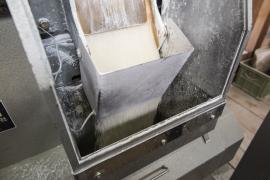 Rice polishing machine
Rice polishing machine
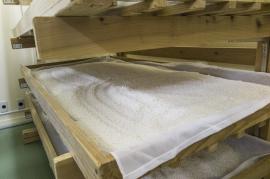 Koji rice
Koji rice
After a comprehensive view of the sake processes, a stand-up sake tasting involved such delights as:
• a smooth, rich Toko Junmai Haenuki,
• a Toko Junmai Ginjo Dewasansan,
• a smoky and ripely peachy, even pineappley Toko Daiginjo Yamadanishiki,
• a rich, smooth, dry Toko Junmai Daiginjo Dewasansan,
• a super-fragrant and delicious Toko Junmai Daiginjo Drip Sake
• a powerful apple and pear-like Toko Junmai Ginjo Genshu Haenuki
• a chocolatey, umami-rich Toko Koshu
We then proceeded on foot to the Toko no Sakagura Sake Museum for a perspective on historic sake-making including antique brewing tools and heirloom China dolls passed down in the Kojima family. After a quick break in our hotel, the Tokyo Daiichi Hotel Yonezawa, we were taken for dinner in a former feudal lord’s mansion, Uesugi Hakushaku Tei.
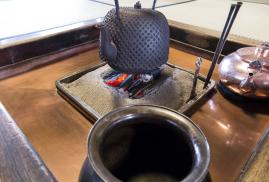 A nice cuppa
A nice cuppa
Dinner featured a five-dish first course based on salmon, dried cod, crunchy ocean scallop followed by marbled Yonezawa beef shabu shabu and shiitake and prawn tempura. Did I mention the sake? Ken Kojima and Yoichiro Umetsu from Yonetsuru Brewery (our sake brewery visit the following day) duly held court as we tasted sakes from both Toko and Yonetsuru.
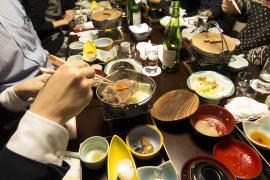 Shabu shabu
Shabu shabu
The dinner sakes from Kojima Sohonten (http://www.sake-toko.co.jp/main.php (in Japanese)
Toko Junmai Daigninjo Fukuro-zuri
Toko Namazake pressed on 19 February
Toko Namazake pressed on 23 Februaru, i.e. that same day
Toko Junmai
The dinner sakes from Yonetsuru (Yonetsuru http://yonetsuru.com/ (in Japanese)
Yontesuru Daiginjo Fukuro-dori Kyosho
Yonetsuru Sparkling
Yonetsuru Marumasu Junmai Ginjo
Yonesturu Tokubetsu Junmai Kissui
A few general facts about sake mostly gleaned from John Gauntner’s seminar:
1. Sake is brewed, not distilled, and has an average alcohol content of around 16%. It’s a traditional product, made from either special sake rice, or table rice, in the autumn following the rice harvest and throughout the winter until March or April.
2. Sake has been around for 1000 years but premium sake such as ginjo, as we know it today, has only been in existence for the last 30 or so years and has about 10 per cent of the total market.
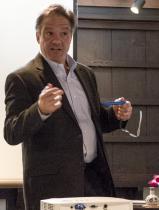 John Gaunter makes a point
John Gaunter makes a point
3. Basic sake, called futsu-shu, like basic table wine, has been in long-term decline. However, there is a lot of interest, both in Japan, and on export markets, in the premium styles, mainly junmai (10.5%), ginjo and daiginjo (10.5%), which together with honjozo (10.8%), also a premium sake, make up around 32% of total sake production.
4. There are about 1200 actives sake breweries in Japan (compared to 80,000 Shinto shrines!) and they range in size from almost industrial to small family businesses. The 15 biggest sake breweries make up 50% of sake production.
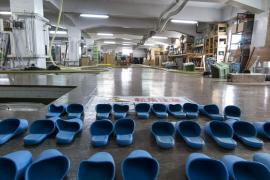 Kojima Sohonten, in the brewery
Kojima Sohonten, in the brewery
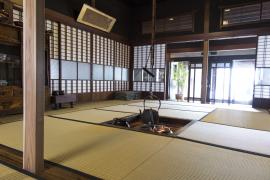 Kojima Sohonten, in the house
Kojima Sohonten, in the house
5. Grades of sake are based on polishing rates, in other words the amount of the rice grain that has been milled away by machine , leaving the centre of the rice grain, which is composed of starch that can be converted into sugar by use of the koji mould. The koji mould contains enzymes that break down the starch in the rice to create fermentable sugars.
6. As with wine, there is regionality in sake. The regional differences depend on a number of factors, most notably type and quality of rice, relative softness of the water, polishing rate and the individual philosophy of each brewer. As a rule, the further north you go in Japan, the more elegant and fine-grained the style of sake becomes, and the further south, the richer, fuller and big-boned.
7. Sake is one of the most versatile drinks and not only goes with fish but, either chilled or at room temperature, and sometimes warm too, with many Western-style dishes too. For instance, ginjo and daiginjo sake goes well with sashimi, but equally, the premium styles can go well with meat such as yakitori (barbecued on the grill) and shabu-shabu (beef cooked in dashi stock over a flame), both highly popular.
8. Further proof that sake pairs well with beef is provided by some local traditional matches. For example, In Yamagata, sake is paired with Yonezawa beef, which is Okitama-raised beef marinated in miso and then grilled, as well as the local soft meatball, which is steamed and eaten with pickled vegetables.
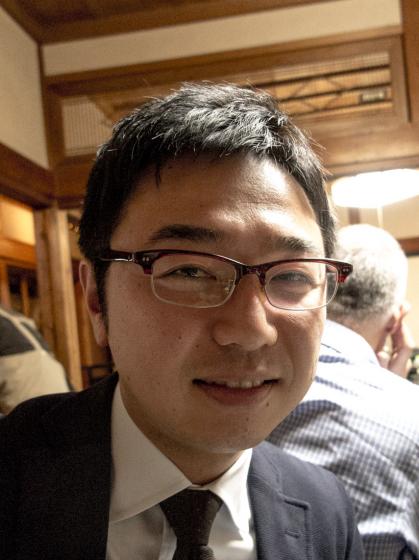 Ken Kojima
Ken Kojima

